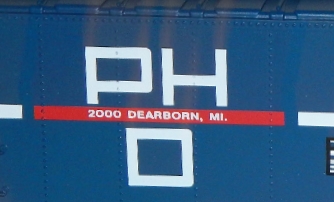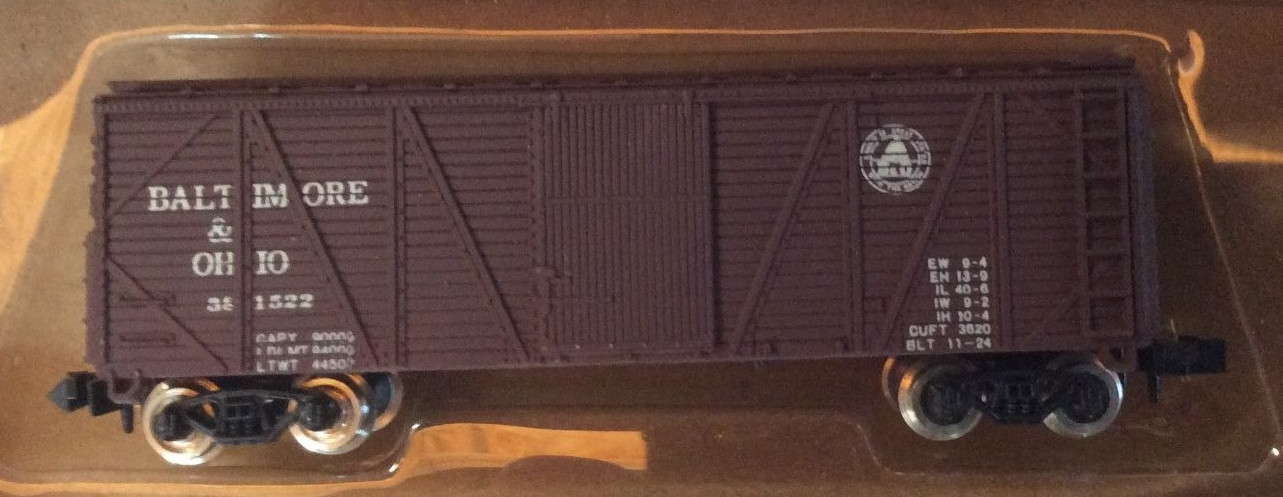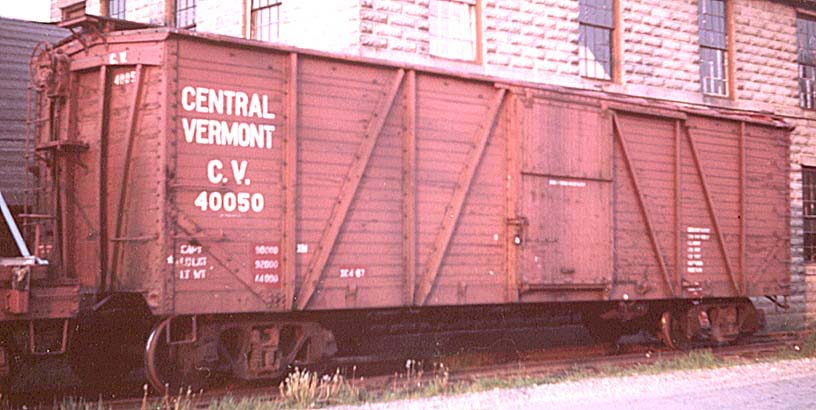Model Information: This boxcar was originally produced for Con-Cor by Kato. Later production was moved to Con-Cor's Chicago facility.
Prototype History: The outside braced single sheathed box car proved to be a significant development in railway freight car technology in North America. Thousands of them saw use on North American railways beginning in the late 19th century through the 1960s. They carried bulk products such as grain and coal. They also carried packaged or bagged lading referred to as clean lading. While most of the outside braced cars were built for general service, some were built specifically to carry machinery and automobiles. For forty years freight trains on the prairies and indeed all across the country consisted of long lines of outside braced boxcars. They could commonly be found at elevators and loading platforms in communities small and large. They dominated railway yard scenes well into the 1940s.
The use of steel for the under frame (center and side sills), side and end frames initiated a new form of railway freight car building technology. Steel center sills and other under sill framing gave the cars the strength necessary to withstand the stress of longer and faster trains as well as the considerable stress involved in the contact necessary to activate closure of the knuckle coupler while being made up into trains in rail yards or from being picked up from local sidings along the line. The steel frame and the single wood side sheath minimized the weight of the car. This type of car design led to easy construction and repair. Its initial construction cost was low. The design provided secure joints between sides, ends and floors which prevented grain leakage.
The use of steel for the under frame (center and side sills), side and end frames initiated a new form of railway freight car building technology. Steel center sills and other under sill framing gave the cars the strength necessary to withstand the stress of longer and faster trains as well as the considerable stress involved in the contact necessary to activate closure of the knuckle coupler while being made up into trains in rail yards or from being picked up from local sidings along the line. The steel frame and the single wood side sheath minimized the weight of the car. This type of car design led to easy construction and repair. Its initial construction cost was low. The design provided secure joints between sides, ends and floors which prevented grain leakage.
Road Name History:  The PH&D was established in 1917 to purchase and extend the Port Huron & Southern Railroad. While there were grand plans to build to Detroit, the PH&D only got from Port Huron to Marine City, Michigan, 14 miles away. Nevertheless, the PH&D kept busy hauling auto parts, coal, salt, steel, chemicals, rubber and sugar beets. In the steam era, PH&D hosted a fleet of 0-6-0 switchers. These were gradually replaced with a trio of Alco diesel switchers. The Duffy Family who had owned the railroad since 1922, sold it to Chesapeake & Ohio in 1984. C&O successor CSX officially merged it into their system in 1989. CSX continues to operate the route.
The PH&D was established in 1917 to purchase and extend the Port Huron & Southern Railroad. While there were grand plans to build to Detroit, the PH&D only got from Port Huron to Marine City, Michigan, 14 miles away. Nevertheless, the PH&D kept busy hauling auto parts, coal, salt, steel, chemicals, rubber and sugar beets. In the steam era, PH&D hosted a fleet of 0-6-0 switchers. These were gradually replaced with a trio of Alco diesel switchers. The Duffy Family who had owned the railroad since 1922, sold it to Chesapeake & Ohio in 1984. C&O successor CSX officially merged it into their system in 1989. CSX continues to operate the route.

Brand/Importer Information: Con-Cor has been in business since 1962. Many things have changed over time as originally they were a complete manufacturing operation in the USA and at one time had upwards of 45 employees. They not only designed the models,but they also built their own molds, did injection molding, painting, printing and packaging on their models.
Currently, most of their manufacturing has been moved overseas and now they import 90% of their products as totally finished goods, or in finished components. They only do some incidental manufacturing today within the USA.
Important Note: The Con-Cor product numbering can be very confusing. Please see here in the article how to properly enter Con-Cor stock numbers in the TroveStar database.
Currently, most of their manufacturing has been moved overseas and now they import 90% of their products as totally finished goods, or in finished components. They only do some incidental manufacturing today within the USA.
Important Note: The Con-Cor product numbering can be very confusing. Please see here in the article how to properly enter Con-Cor stock numbers in the TroveStar database.
Item created by: gdm on 2016-12-14 09:53:49. Last edited by gdm on 2020-04-20 09:43:28
If you see errors or missing data in this entry, please feel free to log in and edit it. Anyone with a Gmail account can log in instantly.
If you see errors or missing data in this entry, please feel free to log in and edit it. Anyone with a Gmail account can log in instantly.










